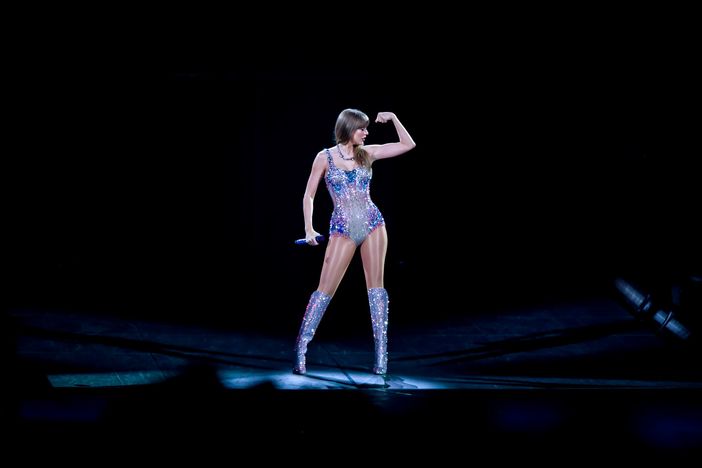University of Houston lines up entrepreneurship course featuring Taylor Swift's billion-dollar career
Cougar Red (Taylor's Version)
By any measure, Taylor Swift put on a masterclass with her Eras Tour this year — her Houston stop was a study in three-hours of pop-culture-perfect brand execution and fan frenzy.
Now, University of Houston is taking Tay studies to the next level with a new biz class.
Appropriately dubbed “The Entrepreneurial Genius of Taylor Swift,” the new class is part of the curriculum at coming to the C. T. Bauer College of Business at the University of Houston next spring. Swfities who’re super “ready for it,” however, can get a jump on enrollment now.
Study “the 1” at a No. 1 institution
Though Swifties and Tay (and Travis) fiends will surely soak up every class hour, the program isn’t just for fans, the prof notes in a press statement. And Bauer College offers serious cred for current and new students, as its Wolff Center for Entrepreneurship has long ranked No. 1 in the U.S.
“You definitely don’t have to be a hardcore fan — a Swiftie — to learn and appreciate the entrepreneurial genius that has made Taylor Swift an international phenomenon,” notes Kelly McCormick, the Professor of Practice leading the course, citing Swift’s expertise in marketing, fan engagement, community building, and brand strategies.
Don’t hate, hate, hate, hate, hate on this Tay tutorial
Sure, Swift haters night hate on a Taylor course. But before they do, they should consider that at age 33, Swift boasts an estimated net worth of $1 billion, according to Forbes. And her aforementioned Eras Tour? Swift earned more than $780 million on the U.S. leg alone this year on the tour, which — by current estimates — cues her up to become the highest-grossing female touring artist of all time.
Her Eras Tour concert film also just became the highest-grossing concert film in North America, raking between $95 million to $97 million in ticket sales during its opening weekend — alone.

Swift can flex a $1 billion net worth, per Forbes. Photo by Marco Torres/Marco from Houston
And then of course, her music acumen and savvy. In 2021, Swift smartly re-recorded a version of her album Fearless and launched a series of releases of her back catalog, in order to secure ownership of her first six albums.That move came after the masters (the original recordings) sold for a reported $300 million in 2019.
Here in Houston, as CultureMap reported, the Post-Tay Effect (we’re making that a thing) had a lasting economic effect, notbaly for areas pet and food nonprofits.
Hardcore business aside, the class Still, the course will be Taylor-made for Swifties. McCormick, who also serves as managing director for the university’s startup accelerator RED Labs, has themed each session around a different album — or Era, obvi for fans — of Swift’s career.
What to expect on the “mornin' of your very first day”
So, when students take a deep breath and walk through the door of their very first day (obligatory “Fifteen,” callout) they will score friendship bracelet gifts — a huge Swiftie phenomenon — and will be treated to surprise songs during breaks and even Easter eggs hidden in class content. (That’s a clever nod to Swift, who regularly hides clues, callbacks, and “oh yeaaahhhh” moments for fans in her music videos, album artwork, and social media posts).
As for the Tay inspo, McCormick says she has been a Swift fan since the early days of mega-hits “Our Song” and “Love Story.” But like so many who were blown away by the sheer Tay Machine during the Houston Eras Tour stop in April, the professor quickly noted entrepreneurship lessons to be learned over Swift’s in her 17-year career.

The professor says Swift's dazzling Eras Tour stop in Houston inspired the class. Photo: Bob Levey/Getty Images/Taylor Swift Twitter
“I saw the show and loved it,” McCormick adds. “And I realized I actually didn’t know that much about her career. I became absolutely enamored basically overnight and started getting into her whole discography. Taylor is truly impressive!”
She added: “Never have I ever — like ever — been so engrossed in someone’s career after so little time.” (Should anyone doubt all the Tay references, McCormick’s “never have I ever — like ever” comments is shoutout to Swift’s most popular singles, “We Are Never Ever Getting Back Together.” Very clever.)
Travis-Tay included?
But perhaps the top Tay lesson is how to ensure satisfied customers.
“The number one business lesson students can learn from Taylor is the way she treats her fans,” McCormick notes. “She is beloved because she truly does so much to make sure they are happy, appreciated and feel like they are important to her. If every company acted that way about their customers — they’d have way more customers.”
Oh, and, no word — and we didn’t ask, for the record — if Kansas City Chiefs tight end/Swift squeeze Travis Kelce is part of the curriculum. Also no word if, to quote “Fifteen,” students will “sit in class next to a redhead named Abigail.”
------
This article originally ran on CultureMap.

 First large-scale affordable housing project of 3D-printed homes rises in Houston Zuri Gardens is getting closer to completion. Courtesy rendering
First large-scale affordable housing project of 3D-printed homes rises in Houston Zuri Gardens is getting closer to completion. Courtesy rendering